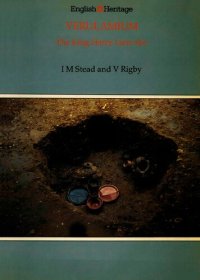
Ebook: Verulamium: the King Harry Lane Site
Author: Ian Mathieson Stead Valery Rigby
- Genre: History // Archaeology
- Series: English Heritage Archaeological Reports 12
- Year: 1989
- Publisher: English Heritage & British Museum Publications
- City: London
- Language: English
- pdf
With contributions by B. M. Ager, Justine Bayley, P. T. Craddock, Elisabeth Crowfoot, Peter Curnow, Simon Davis, Brenda Dickinson, J. Evans, Vanessa Fell, I. C. Freestone, Roger Goodburn, K. F. Hartley, D. R. Hook, R. P. J. Jackson, Catherine Johns, C. A. Keepax, I. H. Longworth, N. D. Meeks, A. P. Middleton, Jennifer Price, Richard Reece, Ann Stirland, Jacqui Watson, David Williams.
Ebook (PDF) published 2013.
The King Harry Lane site, immediately outside the walls of Verulamium, was extensively excavated between 1965 and 1968 prior to large-scale housing development. The Roman road to Silchester was located, with adjacent settlement that started about AD 70 as occupation from the Roman town spread along a major route, but ceased abruptly in the middle of the third century AD, apparently when the town walls were built. The extensive Iron Age cemetery, which was discovered by chance during excavation of the settlement, contained 472 burials (all cremations apart from 17 inhumations) and can be assigned to the period AD 1-60. Seven rectilinear ditched enclosures were identified, each with a prominent and rich central burial surrounded by less imposing graves. None of the burials was particularly exotic in terms of quality and type of grave goods; locally-produced pottery predominated, but fine tableware from Roman Gaul occurred in about a quarter of the burials. Metalwork was dominated by the 237 brooches, but knives, mirrors, and toilet instruments also occurred. No weapons were found. The burial record contained with three third- and fourth-century Roman cemeteries which were not investigated in detail. But a new chapter in the history of Verulamium/St. Albans was represented by an Anglo-Saxon cemetery, which was probably used from the middle decades of the seventh century into the eighth century. This cemetery, with its 29 burials (22 of them with grave goods), was fully excavated.
Ebook (PDF) published 2013.
The King Harry Lane site, immediately outside the walls of Verulamium, was extensively excavated between 1965 and 1968 prior to large-scale housing development. The Roman road to Silchester was located, with adjacent settlement that started about AD 70 as occupation from the Roman town spread along a major route, but ceased abruptly in the middle of the third century AD, apparently when the town walls were built. The extensive Iron Age cemetery, which was discovered by chance during excavation of the settlement, contained 472 burials (all cremations apart from 17 inhumations) and can be assigned to the period AD 1-60. Seven rectilinear ditched enclosures were identified, each with a prominent and rich central burial surrounded by less imposing graves. None of the burials was particularly exotic in terms of quality and type of grave goods; locally-produced pottery predominated, but fine tableware from Roman Gaul occurred in about a quarter of the burials. Metalwork was dominated by the 237 brooches, but knives, mirrors, and toilet instruments also occurred. No weapons were found. The burial record contained with three third- and fourth-century Roman cemeteries which were not investigated in detail. But a new chapter in the history of Verulamium/St. Albans was represented by an Anglo-Saxon cemetery, which was probably used from the middle decades of the seventh century into the eighth century. This cemetery, with its 29 burials (22 of them with grave goods), was fully excavated.
Download the book Verulamium: the King Harry Lane Site for free or read online
Continue reading on any device:

Last viewed books
Related books
{related-news}
Comments (0)